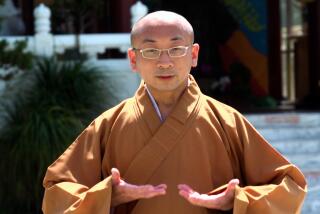Zen and Yoga No Substitutes for Prayer, Vatican Says : Religion: Meditation as physical therapy is distinguished from spiritual enrichment.
- Share via
VATICAN CITY — Urging Catholics to distinguish between spiritual form and substance, the Vatican warned Thursday against substituting Eastern methods of meditation such as Zen and yoga for Christian prayer.
In a 7,000-word letter to bishops approved by Pope John Paul II, the Congregation for the Doctrine of the Faith made a firm distinction between meditation as physical or psychic therapy, and spiritual enrichment.
“Prayer without faith becomes blind, faith without prayer disintegrates,” Cardinal Joseph Ratzinger, the head of the congregation, said in presenting a document he said was intended not to condemn the meditative practices of other religions but to reaffirm guidelines for Christian prayer.
Ratzinger’s congregation defends doctrinal orthodoxy, and its letter to 3,000 Roman Catholic bishops around the world was apparently written to answer complaints from some of them about the growing popularity of mixing Christian meditation with practices common to Hinduism and Buddhism. It apparently was the first time that the Vatican has issued a warning on this topic.
The letter declared that “the love of God, the sole object of Christian contemplation, is a reality which cannot be ‘mastered’ by any method or technique.”
Like the Catholic church, other religions specify how to achieve “union with God in prayer,” the letter noted. “Just as the Catholic Church rejects nothing of what is true and holy in these religions, neither should these ways be rejected out of hand simply because they are not Christian. On the contrary, one can take from them what is useful so long as the Christian conception of prayer, its logic and requirements, are never obscured.”
Some Catholics, the letter noted, believe their prayer is enhanced by techniques borrowed from “various religions and cultures.” It said, though, that such practices “can degenerate into a cult of the body and can lead surreptitiously to considering all bodily sensations as spiritual experiences.”
Attempts to integrate Christian meditation with Eastern techniques that use breath control and prescribed postures like the lotus position can be successful, Ratzinger said, but they are “not free from dangers and errors,” and may boomerang.
“Some physical exercises automatically produce a feeling of quiet and relaxation, pleasing sensations, perhaps even phenomena of light and of warmth, which resemble spiritual well-being. To take such feelings for the authentic consolations of the Holy Spirit would be a totally erroneous way of conceiving the spiritual life. Giving them a symbolic significance typical of the mystical experience, when the moral condition of the person concerned does not correspond to such an experience,” the letter continued, “would represent a kind of mental schizophrenia which could also lead to psychic disturbances and, at times, to moral deviations.”
Some forms of Eastern Christian meditation have “valued psychophysical symbolism, often absent in Western forms of prayer,” the letter noted. “On the other hand, the Eastern masters themselves have also noted that not everyone is equally suited to make use of this symbolism, since not everybody is able to pass from the material sign to the spiritual reality that is being sought. Understood in an inadequate and incorrect way, the symbolism can even become an idol and, thus an obstacle to the raising up of the spirit to God,” the letter asserted.
More to Read
Sign up for Essential California
The most important California stories and recommendations in your inbox every morning.
You may occasionally receive promotional content from the Los Angeles Times.













